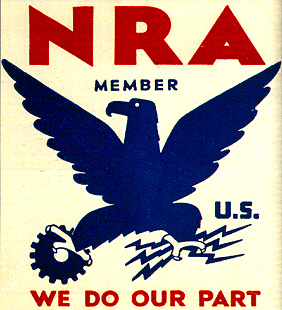Government’s Prohibition of Price Cuts in the Great Depression
 When President Franklin Roosevelt signed the National Industrial Relations Act on June 16, 1933, the National Recovery Administration (NRA) was created. The NRA, one of the major components of Roosevelt’s “New Deal” legislation, was created in response to accusations of “cutthroat competition” and the need for “fair competition.” Economic historian Thomas DiLorenzo explains the “NRA organized each industry into a federally supervised trade association called a Code Authority, which had the authority to regulate production, prices, and distribution methods.” The NRA empowered government bureaucrats and industry executives (as well as the U.S. President), officially called the “Code Authority”, to determine fair prices, wages, and business practices and punish businesses that did not comply with the code. I will examine the punishment businesspeople faced if they broke the regulations established by the Code Authority.
When President Franklin Roosevelt signed the National Industrial Relations Act on June 16, 1933, the National Recovery Administration (NRA) was created. The NRA, one of the major components of Roosevelt’s “New Deal” legislation, was created in response to accusations of “cutthroat competition” and the need for “fair competition.” Economic historian Thomas DiLorenzo explains the “NRA organized each industry into a federally supervised trade association called a Code Authority, which had the authority to regulate production, prices, and distribution methods.” The NRA empowered government bureaucrats and industry executives (as well as the U.S. President), officially called the “Code Authority”, to determine fair prices, wages, and business practices and punish businesses that did not comply with the code. I will examine the punishment businesspeople faced if they broke the regulations established by the Code Authority.
Journalist and economist Henry Hazlitt wrote in 1933, “It is obvious that under the present N.R.A. programme the American consumer is to become the victim of a series of trades and industries which, in the name of ‘fair competition’, will be in effect monopolies, consisting of units that agree not to make too serious an effort to undersell each other; restricting production, fixing prices,—doing everything, in fact, that monopolies are formed to do.” Hazlitt was one of the few public skeptics of the NRA at the time, and it wasn’t long before his predictions proved to be correct.
In less than one year after the formulation of the NRA Jacob Maged, a Jersey City, New Jersey tailor, garnered national interest after failing to comply with the Code Authority. On April 20, 1934 Maged, a Polish immigrant and father of four, was sentenced to a 100 dollar fine and 30 days in the county jail after he pressed a suit for 35 cents, 5 cents below the 40 cent price floor set by the NRA. The New York Times story headline on April 21, 1934 ran, “TAILOR GETS 30 DAYS FOR CUTTING PRICES.” The Times reported, “[Maged] believed that the codes were designed to help the ‘little fellow’ and could not believe that by charging 35 cents instead of 40 cents to press a suit would put him behind bars.” Maged spent three days in jail, and was released after agreeing to comply with the NRA code.
Another famous case of punishment under the NRA came with the Schechter family, who founded and owned Schechter Poultry Corp. in New York City. In April 1934 President Roosevelt approved the “Live Poultry Code” for the New York City poultry industry, and in July 1934 the Schechter’s were arrested and charged for violating the code. The charges against the Schechter’s included failure to operate by the minimum wage and maximum working hours code, as well as selling “unfit chickens” as defined by the Live Poultry Code. (The latter charge is unique because it was an intrastate transaction, which prior to the NRA was outside the regulatory jurisdiction of the federal government.) The Schechter’s pleaded not guilty to all charges, and their case climbed to the heights of the Supreme Court. In Schechter Poultry Corp. v. United States (commonly called the Sick Chicken case) the Supreme Court unanimously sided with the Schechter’s and declared the NRA unconstitutional on May 27, 1935.
The NRA codes were implemented with noble intentions to lessen “cutthroat competition” and level the competitive playing field, but they tended to do just the opposite. The codes expanded both government and corporate power to define regulations and force innocent businesspeople, like Jacob Maged and the Schechter’s, to operate according to the whims of industry executives, government bureaucrats, and the United States President, rather than for the interests of customers. (Obviously it is in the interest of a customer to be charged 35 cents rather than 40 cents to get a suit pressed, but it isn’t in the interest of a competing tailor.) As the Supreme Court confirmed, the NRA was an unconstitutional expansion of congressional and presidential power to regulate local intrastate commerce and control business practices. In the words of Associate Justice Louis Brandeis, “This is the end of this business of centralization, and I want you to go back and tell the president that we’re not going to let this government centralize everything. It’s come to an end.”
Sources
DiLorenzo, Thomas. How Capitalism Saved America. New York: Three Rivers Press, 2004.
Hazlitt, Henry. “The Fallacies of the N.R.A.” The American Mercury. Dec. 1933, 422.
“TAILOR GETS 30 DAYS FOR CUTTING PRICES.” The New York Times. 21 Apr. 1934.
http://mises.org/pdf/tailor_imprisoned.pdf (4 Nov. 2010)
“Schechter Poultry Corp. v. United States – Further Readings”. Law Library – American Law and Legal Information.
http://law.jrank.org/pages/10018/Schechter-Poultry-Corp-v-United-States.html (8 Nov. 2010).
Harry Hopkins, “Statement to Me by Thomas Corcoran Giving His Recollections of the Genesis of the Supreme Court Fight,” April 3, 1939, typescript in Harry Hopkins Papers.

